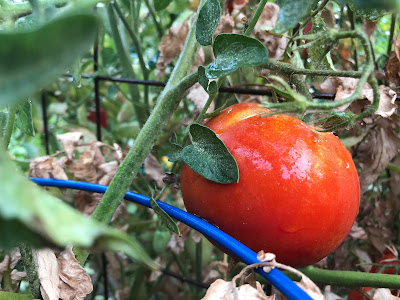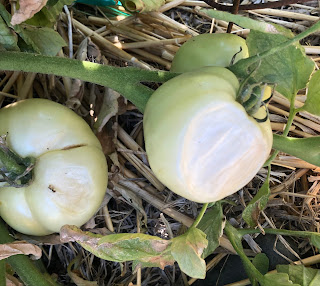
Soil moisture is key to survival in triple-digit temperatures

|
|
Spraying tomato plants with water early in the
morning helps fight spider mites and aphids while
refreshing the leaves and raising the humidity
around the plants. The runoff helps the plants, too.
(Photos: Kathy Morrison)
|
As the weather forecasters like to say: We’re having a heat wave!
Triple-digit days dominate our Sacramento forecast at least through Saturday. In its Excessive Heat advisory, the National Weather Service warns, “Drink plenty of water; don’t wait until you’re thirsty.”
That same advice applies to your garden. Plants with roots in soil that stays evenly moist – not soggy – have the best chance of surviving, even thriving during this heat wave.
The secret is to keep the soil from completely drying out – not on top, but down 4 to 6 inches in the root zone. Use a moisture meter to check. Or use a long-handled screwdriver; if you can’t shove it in 6 inches, you need to irrigate.
Potted plants in containers are especially at risk. The rootball contracts as it dries out, leaving gaps around the sides of the pot. When you pour water on a severely dry potted plant, the water tends to run out the sides without ever penetrating the rootball. In such cases, you may need to submerge the pot in water, let soak for a few minutes, then drain. Don’t let the roots sit in standing water; they’ll suffocate.
Wilting in the heat of the afternoon is normal for many plants, especially those with big thin leaves such as hydrangeas or squash. But if plants are wilted in the morning, water immediately.

|
|
Burlap or shade cloth can help prevent sunburn
on tomatoes or other summer vegetables.
|
Spider mites in particular are loving this heat; this itty-bitty arachnid thrives in hot and dusty conditions. If you see wispy webs covering leaves and stems of shrubs and other plants, knock them down with a strong stream of water from the hose.
This summer shower destroys their webs and washes the mites and dirt off the plants. It also disrupts what attracted the mites in the first place – dry, dusty leaves.
Wash mites off plants early in the morning, so the plant’s foliage has all day to dry. Fungal diseases usually aren’t a problem right now; powdery mildew can’t stand anything above 90 degrees.
This same approach also works against aphids. Showering plants is not wasting water; the runoff will go to the plant’s roots. Most plants also absorb moisture via their foliage.
Avoid spraying neem oil or other treatments (often recommended for pest control). The oil coats the plant’s foliage and increases its sensitivity to extreme heat. Instead of helping the plant, the oil “cooks” its tender leaves.
And put off any fertilization until weather cools back to normal. Feeding increases a plant’s water needs. During this heat, it just adds to plant stress.
For more on heat stress and plants, check out this advice from the UC Integrated Pest Management Program: http://ipm.ucanr.edu/PMG/GARDEN/ENVIRON/thermal.html .
Comments
0 comments have been posted.Sacramento Digs Gardening to your inbox.
Food in My Back Yard Series
April 22: Should you stock up on fertilizer? (Yes!)
April 15: Grow culinary herbs in containers
April 8: When to plant summer vegetables
April 1: Don't be fooled by these garden myths
March 25: Fertilizer tips: How to 'feed' your vegetables for healthy growth
March 18: Time to give vegetable seedlings some more space
March 11: Ways to win the fight against weeds
March 4: Potatoes from the garden
Feb. 25: Plant a fruit tree now -- for later
Feb. 18: How to squeeze more food into less space
Feb. 11: When to plant? Consider staggering your transplants
Feb. 4: Starting in seed starting
Sites We Like
Garden Checklist for week of April 27
Once the clouds clear, get to work. Spring growth is in high gear.
* Set out tomato, pepper and eggplant transplants.
* From seed, plant beans, beets, cantaloupes, carrots, corn, cucumbers, melons, pumpkins, radishes and squash. Plant onion sets.
* In the flower garden, plant seeds for asters, cosmos, celosia, marigolds, salvia, sunflowers and zinnias. Transplant petunias, zinnias, geraniums and other summer bloomers.
* Plant perennials and dahlia tubers for summer bloom. Late April is about the last chance to plant summer bulbs, such as gladiolus and tuberous begonias.
* Transplant lettuce and cabbage seedlings.
* Weed, weed, weed! Don’t let unwanted plants go to seed.
* April is the last chance to plant citrus trees such as dwarf orange, lemon and kumquat. These trees also look good in landscaping and provide fresh fruit in winter.
* Feed citrus trees with a low dose of balanced fertilizer (such as 10-10-10) during bloom to help set fruit. Keep an eye out for ants.
* Apply slow-release fertilizer to the lawn.
* Thoroughly clean debris from the bottom of outdoor ponds or fountains.
* Start thinning fruit that's formed on apple and stone fruit trees -- you'll get larger fruit at harvest (and avoid limb breakage) if some is thinned now. The UC recommendation is to thin fruit when it is about 3/4 of an inch in diameter. Peaches and nectarines should be thinned to about 6 inches apart; smaller fruit such as plums and pluots can be about 4 inches apart. Apricots can be left at 3 inches apart. Apples and pears should be thinned to one fruit per cluster of flowers, 6 to 8 inches apart.
* Azaleas and camellias looking a little yellow? If leaves are turning yellow between the veins, give them a boost with chelated iron.
* Trim dead flowers but not leaves from spring-flowering bulbs such as daffodils and tulips. Those leaves gather energy to create next year's flowers. Also, give the bulbs a fertilizer boost after bloom.
* Pinch chrysanthemums back to 12 inches for fall flowers. Cut old stems to the ground.
* Mulch around plants to conserve moisture and control weeds.